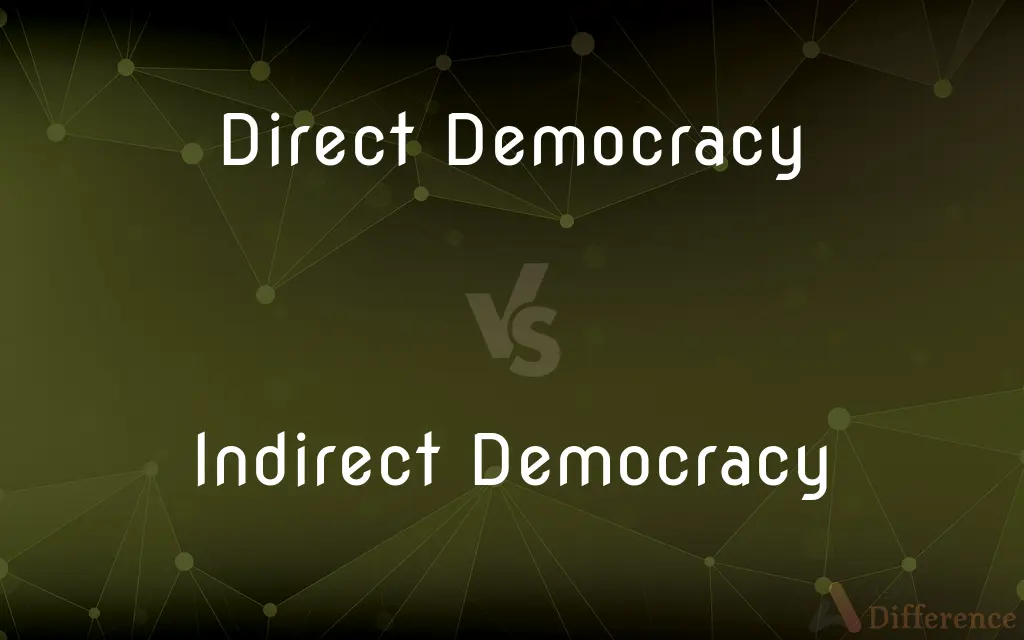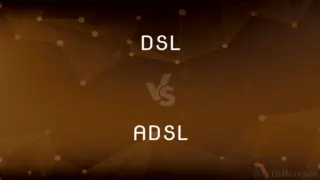Direct Democracy vs. Indirect Democracy — What's the Difference?
By Tayyaba Rehman & Fiza Rafique — Published on October 20, 2023
Direct Democracy allows citizens to make laws directly, while Indirect Democracy has representatives making laws on citizens' behalf.

Difference Between Direct Democracy and Indirect Democracy
Table of Contents
ADVERTISEMENT
Key Differences
In Direct Democracy, every citizen gets the opportunity to participate in the decision-making process. This model insists on involving people in policy-making and legislation. Indirect Democracy, on the other hand, entrusts elected officials with the responsibility of decision-making, placing a buffer between citizens and law formation.
Direct Democracy operates on a principle that emphasizes the direct involvement of citizens in governance. This concept finds its roots in ancient democratic practices. Contrastingly, Indirect Democracy hinges on electing representatives who are mandated to make decisions, often reflecting the complexities of modern-day governance.
In Direct Democracy, the decision-making process can be incredibly inclusive and immediate, involving citizens directly in policy formation and law-making. In contrast, Indirect Democracy necessitates a system where representatives, elected by the public, undertake the crucial task of forming policies and legislating, potentially simplifying complicated matters.
Direct Democracy, by involving citizens directly, can sometimes lead to hasty decision-making driven by the majority's emotions or immediate needs. In the realm of Indirect Democracy, the elected representatives, ideally, provide a layer of deliberation and considered judgement, theoretically insulating the legislative process from impulsive decision-making.
Direct Democracy enforces the will of the majority directly, possibly endangering minority interests. In Indirect Democracy, representatives might ideally balance various interests and safeguard minority rights through structured institutions and legal frameworks.
ADVERTISEMENT
Comparison Chart
Decision Making
Citizens make decisions directly
Representatives make decisions
Participation
All citizens participate
Elected officials participate
Governance Model
Typically smaller communities
Suitable for larger nations
Potential for Populism
Higher
Lower, due to representative mediation
Complexity of Decision-making
Simplified, direct
Can be complex and layered
Compare with Definitions
Direct Democracy
Direct Democracy ensures every citizen's direct participation in governance.
In ancient Athens, Direct Democracy allowed citizens to directly vote on laws.
Indirect Democracy
Indirect Democracy allows for a structured governance system.
In the UK, Indirect Democracy is structured through parliamentary discussions and votes.
Direct Democracy
Direct Democracy embodies the literal application of majority rule.
The Swiss utilize Direct Democracy through frequent referendums on varied issues.
Indirect Democracy
Indirect Democracy involves electing representatives for policy-making.
In the U.S., Indirect Democracy is evident through citizens electing Congress members.
Direct Democracy
Direct Democracy provides a platform for immediate public decision-making.
Through Direct Democracy, Californians often vote on state propositions.
Indirect Democracy
Indirect Democracy creates a buffer between citizens and law-making.
Indirect Democracy allows Canadian citizens to vote for MPs who legislate on their behalf.
Direct Democracy
Direct Democracy inherently excludes a representative layer in governance.
In a Direct Democracy, there would be no senators to pass laws on behalf of citizens.
Indirect Democracy
Indirect Democracy can potentially safeguard against impulsive decisions.
Indirect Democracy in Germany involves systematic checks and balances in law-making.
Direct Democracy
Direct Democracy can sometimes lead to hastily made decisions.
A Direct Democracy might quickly pass a popular but insufficiently deliberated law.
Indirect Democracy
Indirect Democracy ideally balances various societal interests.
Indirect Democracy in India attempts to represent numerous ethnic and religious groups fairly.
Common Curiosities
Which countries prominently use Indirect Democracy?
The United States, India, and Germany, among others.
What is a notable advantage of Direct Democracy?
Direct and immediate citizen involvement in governance.
What is Indirect Democracy?
A system where citizens elect representatives to make decisions on their behalf.
Can Indirect Democracy be seen as less democratic?
Critics argue so, citing the distance between citizens and decision-making.
What is a key disadvantage of Direct Democracy?
Potential for majority tyranny and hasty decisions.
How does Indirect Democracy safeguard against impulsivity?
Through deliberative processes by elected representatives.
Where was Direct Democracy practiced historically?
In ancient Athens.
How are laws passed in Indirect Democracy?
Elected officials debate and pass laws, often in a legislative body.
What is Direct Democracy?
A system where citizens make governmental decisions directly.
How does Direct Democracy treat minority interests?
It may threaten them, as the majority directly imposes its will.
Can Direct Democracy be practiced on a large scale?
It’s challenging due to the complexity and size of large populations.
How do Direct and Indirect Democracy manage complex issues?
Direct Democracy handles them directly, while Indirect Democracy employs representative deliberation.
Is Indirect Democracy always representative of all citizens?
Not necessarily, as representation efficacy can vary based on various factors.
What is an example of Direct Democracy in practice today?
Swiss referendums.
How can citizens influence Indirect Democracy?
Primarily through voting in elections and contacting their representatives.
Share Your Discovery

Previous Comparison
Ronny vs. Ronnie
Next Comparison
DSL vs. ADSLAuthor Spotlight
Written by
Tayyaba RehmanTayyaba Rehman is a distinguished writer, currently serving as a primary contributor to askdifference.com. As a researcher in semantics and etymology, Tayyaba's passion for the complexity of languages and their distinctions has found a perfect home on the platform. Tayyaba delves into the intricacies of language, distinguishing between commonly confused words and phrases, thereby providing clarity for readers worldwide.
Co-written by
Fiza RafiqueFiza Rafique is a skilled content writer at AskDifference.com, where she meticulously refines and enhances written pieces. Drawing from her vast editorial expertise, Fiza ensures clarity, accuracy, and precision in every article. Passionate about language, she continually seeks to elevate the quality of content for readers worldwide.














































